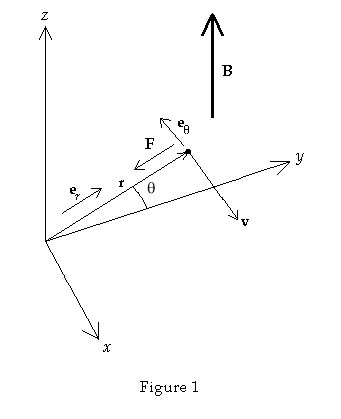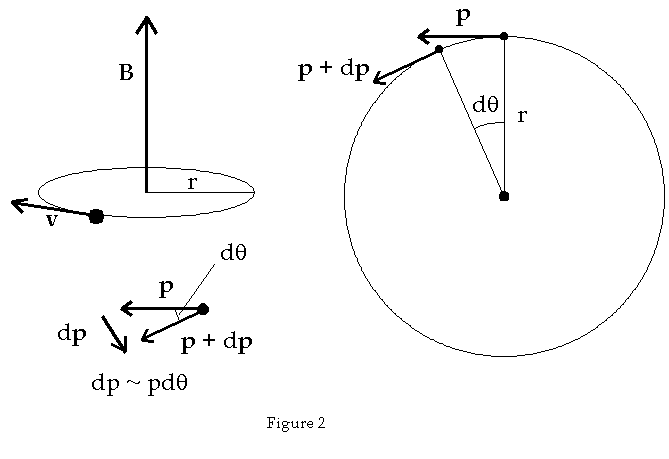Cyclotrons
Back
to Physics World
Back to Special Relativity
Problem: Consider the magnetic field defined by B = B ez (B = constant). Find the trajectory (ignoring radiation effects) of a charged particle whose initial velocity has no z-component and thus initially lies in the xy-plane. I.e. z (t = 0) = 0. Find the trajectory.
Solution:
The
Lorentz force gives the force on a charged particle moving through an
electromagnetic field. This force is defined by
![]()
Since E = 0 Eq. (1) reduces to
![]()
Since v´B
is perpendicular to v it follows that (v´B)·v
= 0. The work-energy theorem states that the work done on a particle equals the
change in particle’s kinetic energy K, i.e. dW = F·dr = dK and therefore dW = F·dr Ž dK/dt = F·(dr/dt) = F·v.
Substituting this into Eq. (2) gives
![]()
The kinetic
energy is thus a constant of motion thus
![]() is also constant and therefore dg/dt
= 0. Constant g
implies the particle’s speed v = |v| is also constant. Since the
B field is in the +z direction and the initial velocity is in the xy-plane
it follows that the force on the particle has no +z component. The
particle thus remains in the xy-plane for the entire trajectory. This
situation is shown in Fig. 1 below where cylindrical coordinates are used.
is also constant and therefore dg/dt
= 0. Constant g
implies the particle’s speed v = |v| is also constant. Since the
B field is in the +z direction and the initial velocity is in the xy-plane
it follows that the force on the particle has no +z component. The
particle thus remains in the xy-plane for the entire trajectory. This
situation is shown in Fig. 1 below where cylindrical coordinates are used.

The
origin of the coordinate system is defined such that the position vector r
is perpendicular to the velocity. In Fig. 1 the particle is shown as a black dot
at the tail of the velocity vector. The unit vectors for cylindrical coordinates
are also shown. It is easy to see that the Lorentz force lies perpendicular to
both the magnetic field and the velocity. The distance from the particle r
is a parameter to be determined below. The figure has been drawn such that the
origin lies in the direction of the force. The torque N is defined as
![]()
The angular momentum of the particle L is defined as
![]()
It can
be shown that the
![]()
According
to the diagram r´F
= 0 and therefore N = 0. An explicit calculation of N shows that
![]()
The velocity vector is given by
![]()
er
and eq
are shown in
Figure 1 above. Substituting this
into Eq. (7) yields
![]()
Substitute
er
´
ez
= - eq
and eq
´
ez
to obtain
![]()
Since
N = 0 and r ¹ 0 it follows that
![]() Ž r = R =
constant. We now have our first integral of motion. Since the speed is constant
it follow from Eq. (8) that
Ž r = R =
constant. We now have our first integral of motion. Since the speed is constant
it follow from Eq. (8) that
![]()
Since
both the speed v and distance r are constant it follows that
angular velocity
![]() is also constant. Constant
r and constant w means that the
trajectory is a circle. From the diagram it is easy to see that a positive
charge q moves in a clockwise motion around the circle. w is known as the cyclotron frequency. To
find an explicit expression for w we start with the expression for the magnitude of the
Lorentz force which is F = qvB. Since the motion is transverse to
the acceleration we also have F = ma = mrw2 = m(rw)w = mvw = qvB . Solving for w gives w= qB/m. Therefore since v = rw then r = v/ w = p/qB.
is also constant. Constant
r and constant w means that the
trajectory is a circle. From the diagram it is easy to see that a positive
charge q moves in a clockwise motion around the circle. w is known as the cyclotron frequency. To
find an explicit expression for w we start with the expression for the magnitude of the
Lorentz force which is F = qvB. Since the motion is transverse to
the acceleration we also have F = ma = mrw2 = m(rw)w = mvw = qvB . Solving for w gives w= qB/m. Therefore since v = rw then r = v/ w = p/qB.
The
momentum is easily derived. The force can be calculated by noting that dp
»
pdq
as shown in the diagram below in Figure 2.

![]()
The
force has a constant magnitude of F = qvB0.
Substituted into Eq. (12) gives
![]()
Solving for p gives the final answer, identical to Eq. (11) as it must be. i.e. p = qB0r.
Back
to Special Relativity
Back to Physics World